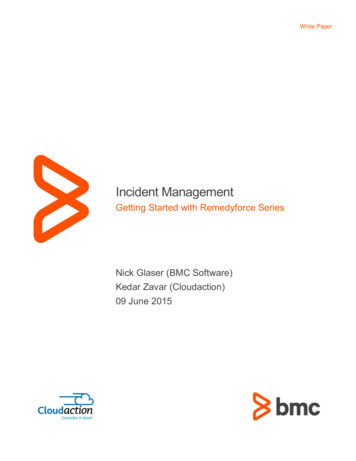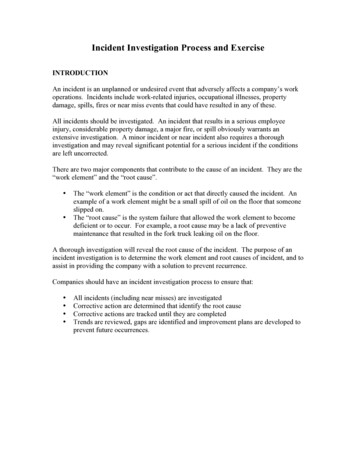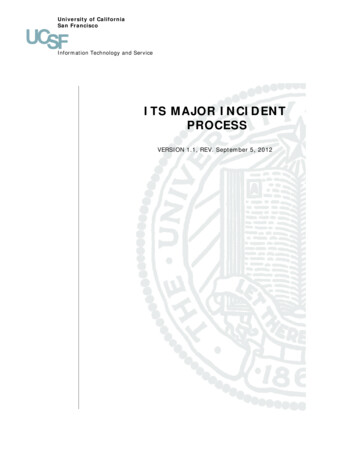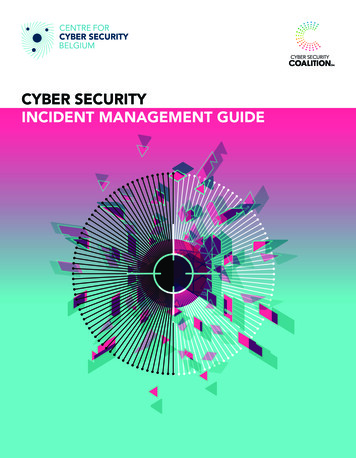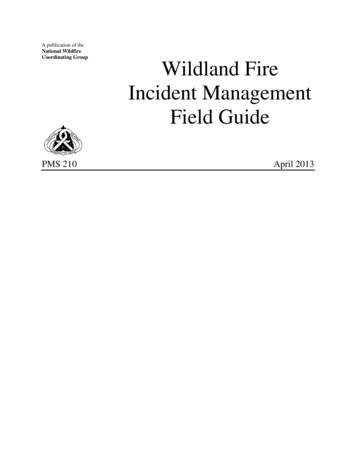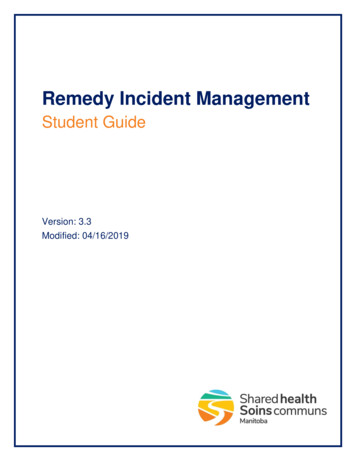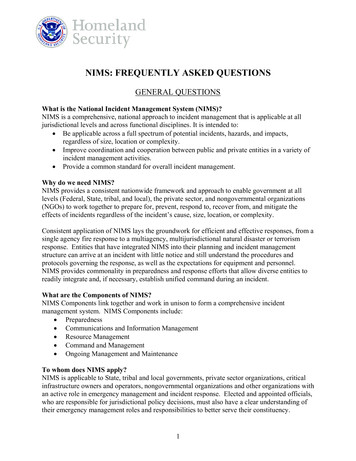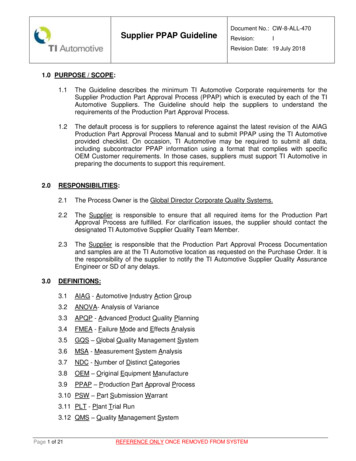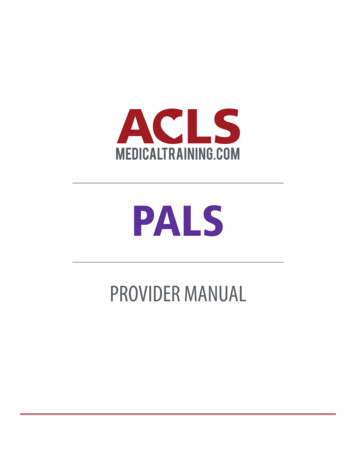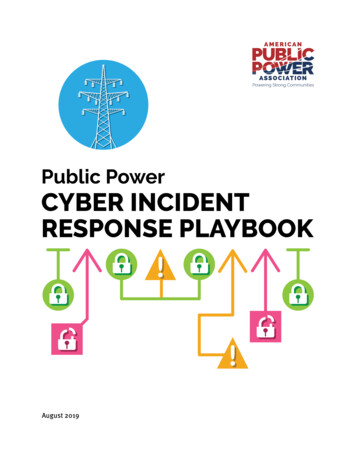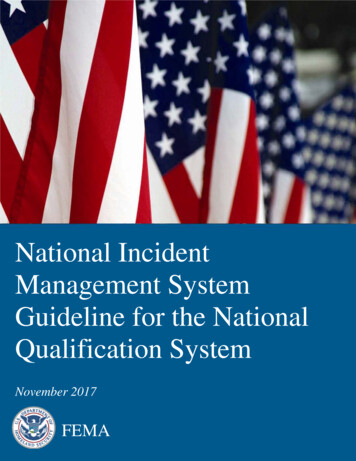
Transcription
National IncidentManagement SystemGuideline for the NationalQualification SystemNovember 2017FEMA
NIMS Guideline for the National Qualification SystemFEMA-NIMS@fema.dhs.gov
FEMA-NIMS@fema.dhs.govNIMS Guideline for the National Qualification SystemContentsI.Introduction . 1II.National Qualification System Overview . 2Concept of Operations . 2NQS Doctrine and Tools . 3Responsibilities of Authorities Having Jurisdiction (AHJ) . 4How NQS Supports NIMS Resource Management and Mutual Aid . 6III.Qualification Process . 7Qualification Criteria . 7Position Prerequisites . 9Position Task Books (PTB) . 10Direct Entry Qualification . 10Portability of Qualifications . 11IV.Certification Process . 12Qualification Review Board (QRB) Evaluation . 12Documentation Review . 12Historical Recognition . 13Training Equivalencies . 14Certification . 14Recertification . 14Decertification . 15Appeals . 16V.Credentialing Process . 17Credentialing, Recertification, and Decertification . 17Glossary . 18List of Abbreviations . 23Resources . 25References . 27Appendix A: Position Task Book (PTB) Guidelines . 28Design and Use . 28i
NIMS Guideline for the National Qualification SystemFEMA-NIMS@fema.dhs.govCompletion Timeframe Guidelines . 28The PTB Process . 29Appendix B: Guidance for Qualification Review Boards (QRB) . 31Overview . 31Description and Establishment of QRBs . 31Tab 1 to Appendix B: Sample Qualification Review Board Templates . 33National Incident Management System (NIMS) Position Qualification ApplicationTemplate. 34Self-Assessment and Evaluation Form Template . 36Sample Decertification Letter . 38Decertification/Removal of Qualification Appeal Template . 39Appendix C: Guidelines for the Credentialing of Personnel . 40Overview . 40Purpose . 40Applicability . 40National Identification Standardization . 41Identity and Qualification Verification . 41Issuance of Identification Cards . 41Revocation. 42Using Credentials in Incidents. 42Authorization and Access . 43Verification . 43Special Application of the Guideline for Local, State, Tribal, Private Sector, and NongovernmentalOrganizational Personnel. 43Credentialing Personnel Who Are Not Certified for Incident-Related Positions . 44Affiliation Access . 44Access Control and Affiliation Documentation. 45Credentialing Unaffiliated Volunteers . 45PIV Interoperable and Compatible Credentials . 46Federal Government PIV Cards . 46PIV-Related Options for Non-Federal Government Organizations . 46ii
FEMA-NIMS@fema.dhs.govNIMS Guideline for the National Qualification SystemCustomizing PIV Interoperable and PIV Compatible Credentials . 46Other Alternatives . 47Appendix D: Position Endorsements. 48Components of an Endorsement . 48Implementation of Endorsements . 48List of FiguresFigure 1: NQS Concept of Operations . 2Figure 2: NQS Doctrine and Tools . 4Figure 3: Example of FIPS 201 PIV Card Format . 47iii
NIMS Guideline for the National Qualification SystemivFEMA-NIMS@fema.dhs.gov
FEMA-NIMS@fema.dhs.govI.NIMS Guideline for the National Qualification SystemIntroductionThe National Qualification System (NQS) supplements the Resource Management component ofthe National Incident Management System (NIMS) by establishing guidance and tools to assiststakeholders in developing processes for qualifying, certifying, and credentialing deployableemergency personnel.This Guideline is for use by any authority having jurisdiction (AHJ), including all levels ofgovernment and organizations, private sector entities, and nongovernmental organizations(NGO) with incident management or support responsibilities. It describes the basic principles ofstandard qualification, certification, and credentialing processes and introduces primary tools tohelp AHJs establish their own processes.Many organizations and jurisdictions have already established processes for qualifying,certifying, and credentialing incident management and support personnel. This Guideline doesnot replace these procedures. Rather, it helps AHJs build or refine qualification, certification, andcredentialing processes to be effective and consistent nationwide. The qualification, certification,and credentialing processes described in the Guideline are voluntary for all non-Federal entities.This document supersedes the 2011 version of the NIMS Guideline for the Credentialing ofPersonnel.The NQS national doctrine promotes interoperability by establishing a common language fordefining job titles and by enabling jurisdictions and organizations to plan for, request, and haveconfidence in the capabilities of personnel deployed for disasters and emergencies from otherentities through mutual aid agreements and compacts. Following the concepts and processes inthis Guideline will enhance national preparedness by expanding the network of qualified incidentmanagement and support personnel who can be deployed nationwide.1
NIMS Guideline for the National Qualification SystemII.FEMA-NIMS@fema.dhs.govNational Qualification System OverviewThe NQS establishes standard minimum qualifications for specific incident-related positions toprovide consistency across the Nation and support nationwide interoperability. 1 Using the NQSapproach to qualify, certify, and credential incident management and support personnel ensurespersonnel deploying through mutual aid agreements and compacts have the capabilities toperform the duties of their assigned roles.Concept of OperationsNQS uses a performance-based approach that focuses on verifying the capabilities of personnelto perform as required in the various incident-related positions. This approach incorporateseducation, training, and experience to build proficiency and establishes performance as theprimary qualification criterion. This approach differs from training-based systems, which use thecompletion of training courses or passing scores on examinations as qualification criteria. Aperformance-based approach is advantageous over a training-based system because it providesgreater confidence of on-the-job performance since evaluators have observed the proficiencies ofthe individual through their performance of a series of pre-designated tasks.Figure 1 depicts the continuum of the integrated qualification, certification, and credentialingprocesses that constitute NQS. A summary of activities for each of the three processes isdescribed below.Figure 1: NQS Concept of Operations Qualification is the process of enabling personnel to perform the duties of a specificposition and documenting their proficiency of the capabilities required by the position.During the qualification process, trainees—individuals seeking to become qualified—meetthe prerequisites for the position they are pursuing by completing training courses, obtainingprofessional or technical licenses and certifications, if appropriate, and meeting the physicaland medical fitness requirements established for the position they are pursuing.1For the purposes of this document, the word “incident” includes planned events as well as emergencies and/ordisasters of all kinds and sizes.2
FEMA-NIMS@fema.dhs.gov NIMS Guideline for the National Qualification SystemCertification is the recognition from the AHJ or a third party2 stating that an individualhas met the established criteria and is qualified for a specific position. As part of thecertification process, a certifying official (CO) and/or Qualification Review Board (QRB)examines the trainee’s records of performance and the evidence that the trainee meets all therequirements for the position, including historical recognition, if appropriate. If the traineemeets all requirements, the CO certifies the individual “qualified” for the position.Please note that the term “certification” in the context of the NQS refers to the AHJ’scertification that an individual is qualified for a specific incident-related position. It is distinctfrom professional certifications and licenses. Recertification is the confirmation that an individual has maintained his/her qualificationfor the position. The AHJ maintains records regarding its personnel and establishesprocedures for the periodic review of these individuals’ qualifications and currency in theirpositions. This may result in a formal periodic recertification or decertification if individualsno longer meet minimum qualification standards or are not current in the positionrequirements. Recertification periods may vary depending on the position. It is ultimately upto the AHJ to establish the recertification timeframe. Credentialing is the process of providing documentation that identifies personnel andverifies their qualifications for certain positions. Once an individual is certified for aposition, the AHJ issues an identification card or badge—a credential—attesting to theidentity of the individual and his/her qualifications and affiliations. AHJs determine whatkind of identification card, badge, or other identification document to issue. Examples ofcredentials include, but are not limited to, the basic Incident Qualification CertificationSystem Card, used by some AHJs who support wildland fire responses, and a radiofrequency identification (RFID)-chipped Personal Identity Verification (PIV) card with thecapacity to contain significantly more detailed information about the individual.NQS Doctrine and ToolsThe Federal Emergency Management Agency (FEMA) supports the NQS by providing guidanceand tools to assist AHJs and help assure the integrity of the system. Figure 2 depicts the doctrineand tools within the NQS.2Within the criteria entitled “Professional and Technical Licenses and Certifications,” certain positions may requirethird-party certification and/or credentialing from an accredited body, such as a state licensure board for medicalprofessionals as a component of the overall qualification for the position.3
NIMS Guideline for the National Qualification SystemFEMA-NIMS@fema.dhs.govFigure 2: NQS Doctrine and Tools The Guideline for the National Qualification System provides guidance on building andmaintaining a process for creating a deployable workforce of qualified, certified, andcredentialed personnel to manage and support incidents of all types and sizes. A set of NIMS Job Titles/Position Qualifications define the minimum criteria that personnelserving in specific incident-related positions must attain before deploying to an incident.These criteria describe not only required capabilities, but also describe specific education,training, experience, physical/medical fitness, currency, and professional and technicallicenses and certifications, when appropriate. NIMS Position Task Books (PTB) identify the competencies, behaviors, and tasks personnelmust demonstrate to qualify for specific incident-related positions. PTBs are a standardizedtool for observing and documenting the trainee’s performance and are widely used byorganizations, associations, and governmental entities to qualify incident management andsupport personnel. A key tool of the NQS qualification process, PTBs: ‒Provide an observable, measurable, and standardized means to document the trainee’sproficiency by describing specific tasks, behaviors, and competencies for each position;and‒Streamline and standardize the evaluation process by enabling evaluators to observe anddocument the trainee’s performance during qualifying incidents, events, job activities,exercises, or classroom activities.Support Technologies assist stakeholders in implementing effective qualification andcertification processes. For example, the Resource Typing Library Tool (RTLT) is an onlinecatalog containing resource-typing definitions, NIMS Job Titles and their correspondingPosition Qualifications, and NIMS PTBs.Responsibilities of Authorities Having Jurisdiction (AHJ)The NQS is a nationwide system with dispersed responsibilities among its many partners. WhileFEMA provides guidance and tools, AHJs are responsible for qualifying, certifying, andcredentialing personnel. AHJs are encouraged to implement qualification, certification, and4
FEMA-NIMS@fema.dhs.govNIMS Guideline for the National Qualification Systemcredentialing processes consistent with NQS guidance to ensure their personnel are prepared toperform the responsibilities associated with their specific incident-related positions.Authorities Having Jurisdiction (AHJ)AHJ is the NIMS term for entities that have the authority and responsibility to develop, implement,maintain, and oversee the qualification, certification, and credentialing process within their organizationor jurisdiction. AHJs include state, tribal, or Federal Government departments and agencies, trainingcommissions, NGOs, or companies, as well as local organizations, such as police, fire, public health, orpublic works departments.AHJ responsibilities include pre-identifying, typing, and qualifying incident management orsupport personnel based on minimum qualification criteria that align with the NIMS Job Titles/Position Qualifications. Federal departments and agencies may use existing processes withintheir organizations to qualify, certify, and credential their incident management and supportpersonnel, 3 but these processes should be consistent with NQS doctrine.The AHJ issues a trainee the appropriate PTB, and the trainee works with coaches to documentthe knowledge, skills, and ability to perform the tasks required for the position. A coach is anindividual who provides instructions and mentoring to a trainee.AHJs may augment the NIMS Position Qualifications minimum criteria to meet specific needs,hazards, or risks within their jurisdiction, organization, or agency. When an AHJ requests aresource through mutual aid, if the resource needs qualifications beyond the NIMS positionqualifications, the AHJ documents that requirement as part of the request. Resource providerscan use position endorsements to validate individuals’ additional capabilities, typicallyassociated with specific hazards that augment the minimum qualifications for the position.For positions not defined in the NIMS Job Titles/Position Qualifications, AHJs should useorganizational and industry guidelines to type the positions and establish employeequalifications. NQS addresses both incident management and support (e.g., emergencyoperations centers) positions.AHJs that do not have an existing process, are qualifying new disciplines, or have limitedresources may incorporate best practices from other, more experienced organizations. Thisprocess may include leveraging coaches and evaluators from neighboring states, localities, orprofessional organizations until these AHJs have developed their own cadre of qualified andcertified personnel. AHJs may also contact Federal departments and agencies, such as FEMA,for technical assistance.Prior to developing qualification, certification, and credentialing processes, AHJs should: Research comparable processes in similar organizations (government, NGOs, and the privatesector), Identify all incident-related positions within their organization, and36 United States Code (U.S.C.) § 320 and Homeland Security Presidential Directive 5 (HSPD-5).5
NIMS Guideline for the National Qualification System FEMA-NIMS@fema.dhs.govDetermine the advantages and disadvantages of jointly developing or sharing systems withother AHJs.How NQS Supports NIMS Resource Management and Mutual AidThe Resource Management component of NIMS involves four key activities: typing resources;qualifying, certifying, and credentialing incident management and support personnel; planningfor resources; and acquiring, storing, and inventorying resources. NQS guidance and toolssupport the all-important processes of typing personnel and ensuring they have the ability toperform as needed.Sharing emergency resources among jurisdictions and organizations is an important emergencypreparedness strategy used throughout the Nation every day. Using NQS to certify and credentialpersonnel allows an AHJ to share a common language of defined minimum capabilities withother entities. This common framework makes the sharing of emergency resources through theprocess of mutual aid both possible and practical.NQS also supports the development of mission-ready packages (MRP), which are mechanismsused to organize, develop, train, and exercise capabilities prior to an incident. Having qualifiedpersonnel who have the knowledge, skills, and abilities needed for their job positions allows anAHJ to identify personnel as part of their MRPs.Establishing and maintaining both formal and informal mutual aid arrangements enhancespreparedness and readiness by enabling communities and organizations to activate, deploy,share, and scale resources rapidly across jurisdictions and organizations. The NIMS Guideline forMutual Aid provides additional information on these types of agreements. 446See the NIMS Guideline for Mutual Aid. id).
FEMA-NIMS@fema.dhs.govNIMS Guideline for the National Qualification SystemIII. Qualification ProcessNQS qualification is the process of: Enabling personnel to perform the duties of specific incident-related positions and meet anyother prerequisites established for the positions; and Documenting the fact that individuals have demonstrated the capabilities and competenciesrequired for those positions.Enabling personnel to perform the duties of a particular position occurs through a combination oftraining, on-the-job coaching, and experience. Generally, one or more evaluators observe, attestto, and document an individual’s ability to perform specific tasks as described in PTBs.Individuals may be qualified in multiple positions. An AHJ determines how many qualificationsan individual can hold at one time.Qualification CriteriaA key element of developing consistency in positions is establishing minimum criteria thattrainees must meet to be qualified in a specific position. To assist AHJs in establishing consistentcriteria for positions, the RTLT contains information regarding NIMS Job Titles/PositionQualifications for the positions that organizations are most likely to request through mutual aid.AHJs can use this information to help determine what education, training, experience,physical/medical fitness, currency, and professional and technical licenses and certifications arenecessary for specific positions. NIMS Job Titles/Position Qualifications in the RTLT alsoestablish minimum criteria to perform in a position in incidents at a particular complexity level.Incident ComplexityIncident complexity is the combination of involved factors that affect the probability of control of anincident. Many factors determine the complexity of an incident, including, but not limited to, areainvolved, threat to life and property, political sensitivity, organizational complexity, jurisdictionalboundaries, values at risk, weather, strategy and tactics, and agency policy. Incident complexity isconsidered when making incident management level, staffing, and safety decisions. Incident complexityis assessed on a five-point scale ranging from Type 5 (the least complex incident) to Type 1 (the mostcomplex incident).AHJs can use the NIMS Job Titles/Position Qualifications captured in the RTLT as a baseline,but they also have the flexibility to expand the qualifications based on the needs orcircumstances of their jurisdiction or organization.Examples of qualification criteria include: Performance: Completing the PTB required for the position. Education: Formal instruction based on a curriculum that prepares an individual with thecore knowledge, skills, and ability to enter into a discipline and perform job functions. Training: Courses that must be completed prior to becoming qualified in a position.7
NIMS Guideline for the National Qualification SystemFEMA-NIMS@fema.dhs.gov Experience: Being qualified for and serving in subordinate and other pertinent positions,measured in terms of time spent applying the specific skills associated with the position. Physical/Medical Fitness: Physical and medical considerations that, when applied, help toensure safe performance in potentially hazardous environments. AHJs determine the methodof evaluating the physical fitness levels of their personnel; however, the testing methodshould be a measurable evaluation process. Physical fitness is categorized into four levels:‒Arduous – Duties involve fieldwork requiring physical performance calling for aboveaverage endurance and superior conditioning. These duties may include an occasionaldemand for extraordinarily strenuous activities in emergencies under adverseenvironmental conditions and over extended periods of time.‒Moderate – Duties involve fieldwork requiring complete control of all physical faculties.Occasional demands may be required for moderately strenuous activities in emergenciesover long periods.‒Light – Duties mainly involve office-type work with occasional field activitycharacterized by light physical exertion requiring basic good health.‒None required – Positions that do not require a physical fitness level.The following example presents a sample qualification requirement for an emergency medicaltechnician (EMT) position currently posted on the RTLT.EMERGENCY MEDICAL TECHNICIANDESCRIPTION: The primary focus of the Emergency Medical Technician (EMT) is to provide basictriage, assessment, and noninvasive interventions to reduce the morbidity and mortality associated withacute out-of-hospital medical and traumatic emergencies. This may occur at an emergency scene untiltransportation resources arrive, from an emergency scene to a health care facility, or between healthcare facilities. Additionally, the EMT possesses the education and experience in areas of patient carethat are commensurate with the patient care mission, providing care to minimize secondary injury, andprovide comfort to the patient and family while transporting the patient to an emergency care facility. TheEMT level is the minimum licensure level for personnel transporting patients in ambulances.EDUCATION: Completion of a state-approved EMT program based on National Highway Traffic SafetyAdministration (NHTSA) National Standard Curriculum.Recommended: Successful completion of the minimum terminal learning objectives for an EMT asdefined by NHTSA National Emergency Medical Services (EMS) Education Standards.TRAINING:1. IS-100: Introduction to Incident Command System (ICS) or ICS-100.2. IS-700: National Incident Management System (NIMS), an Introduction.3. IS-800: National Response Framework (NRF), an Introduction.4. HazMat Awareness Training or equivalent basic instruction consistent with:8a.The hazards anticipated to be present, or present at the sceneb.The probable impact of those hazards, based upon the mission role of the individual
FEMA-NIMS@fema.dhs.govc.NIMS Guideline for the National Qualification SystemUse of the personal protective equipment consistent with “Guidance on Emergency ResponderProtective Equipment (PPE) for Response to CBRN [chemical, biological, radiological, ornuclear] Terrorism Incidents,” Department of Health and Human Services, Centers for DiseaseControl and Prevention, National Institute for Occupational Safety and Health (June 2008).EXPERIENCE: Ongoing, active participation with an EMS-providing entity, org
credentials include, but are not limited to, the basic Incident Qualification Certification System Card, used by some AHJs who support wildland fire responses, and a radio-frequency identification (RFID)-chipped Personal Identity Verification (PIV) card with the capacity to contain sign

